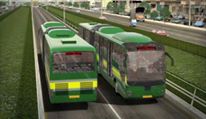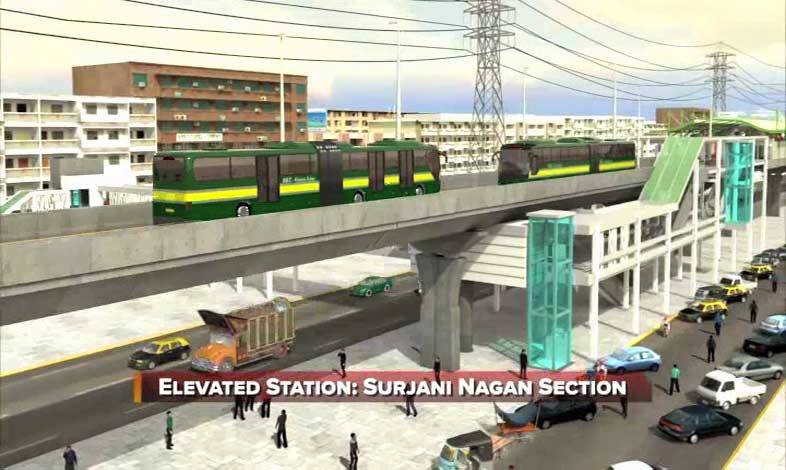KARACHI: Prime Minister Nawaz Sharif inaugurated the Green Line Bus Rapid Transit System (BRTS) at Karachi’s Anu Bhai Park on Friday.
The project starts from Karachi’s Surjani Town area all the way till Guru Mandir. “Karachi’s Green Line bus project will be more beautiful than the Lahore metro,” the premier said while addressing the inauguration ceremony.
Out of the 17.8km stretch of the Green Line BRT, 9.92km will be elevated and 7.88km will be on ground. There will be a total of 21 stations along its route.
The project will be completed in about a year’s time, and the infrastructure will be handed over to the Sindh government once construction is complete.
A fully autonomous company, the Karachi Infrastructure Development Company Limited (KIDCL) has been incorporated under a board of directors. It comprises a good mix of project stakeholders, including senior government functionaries, independent technical directors and members from the academia to take decisions independently for planning and implementation of the project.
It is expected that after its completion, the corridor will benefit nearly 300,000 passengers per day with an estimated cost of Rs16 billion.
Funding of the entire project has been provided by the federal government, announced in the 2015-16 budget.



The city’s present public transport system constitutes a small percentage of total vehicle fleet (4.5%) and serves about 42% of passenger demand yet not dedicated lanes or any other feasible traffic management solution has been provided as compared to private vehicles, which are roughly 36% of the total vehicular traffic but carry only 21% of passengers. The Para-transit mode constitutes 10% of the vehicle fleet and carries 8% of passengers while contract carriages constitute 2% of the vehicle fleet but carry 10% of total passengers (JICA Person Trip Study, 2005).
The Green Line BRT shares the common corridor with Blue line between Muncipal Park and Gurumandir.
Project Description
This project will constructed a busway (dedicated for BRT vehicles) in the median of the roads along the corridor with stations in the center of the median in both at grade and elevated sections which all provide high speed (25 Km/h) and high capacity (29,400 passengers per hour per direction) service. The design capacity of the proposed BRT system with passing lanes provision will increase based on the number of direct / express services run between stations in the future, as required.
The project starts from Karachi’s Surjani Town area all the way till Guru Mandir. “Karachi’s Green Line bus project will be more beautiful than the Lahore metro,” the premier said while addressing the inauguration ceremony.
Out of the 17.8km stretch of the Green Line BRT, 9.92km will be elevated and 7.88km will be on ground. There will be a total of 21 stations along its route.
The project will be completed in about a year’s time, and the infrastructure will be handed over to the Sindh government once construction is complete.
A fully autonomous company, the Karachi Infrastructure Development Company Limited (KIDCL) has been incorporated under a board of directors. It comprises a good mix of project stakeholders, including senior government functionaries, independent technical directors and members from the academia to take decisions independently for planning and implementation of the project.
It is expected that after its completion, the corridor will benefit nearly 300,000 passengers per day with an estimated cost of Rs16 billion.
Funding of the entire project has been provided by the federal government, announced in the 2015-16 budget.

Ministry of Communications Govt. of Pakistan
Project Profile
The
project is to be undertaken by Government of Pakistan/ Ministry of
Communications as a high priority project as determined by Japan
International Cooperation Agency (JICA) in their Feasibility Study
conducted for Karachi Transportation Improvement Project (KTIP, 2030) in
December, 2012. The Prime Minister of Pakistan, during a high level
meeting in Karachi on July 10, 2014, announced to provide infrasturcture
component to launch the BRT Green Line project on modern lines to
alleviate the serve traffic congestion problems in the city and to
improve the quality of life of the daily commuters by improving the
existing transport system.
Objectives
Karachi city is passing through an uncontrolled phase of rapid urbanization and motorization. The mitigation of transportation externalities requires a shift towards sustainable transportation system.The city’s present public transport system constitutes a small percentage of total vehicle fleet (4.5%) and serves about 42% of passenger demand yet not dedicated lanes or any other feasible traffic management solution has been provided as compared to private vehicles, which are roughly 36% of the total vehicular traffic but carry only 21% of passengers. The Para-transit mode constitutes 10% of the vehicle fleet and carries 8% of passengers while contract carriages constitute 2% of the vehicle fleet but carry 10% of total passengers (JICA Person Trip Study, 2005).
The main project objectives are defined as under:
To provide reliable, safe, affordable, high quality and fast BRT Bus Service
To improve the quality of life of commuters in Karachi
To vastly improve the quality of public transport system in Karachi
To
provide infrastructure that allows buses to ply in an efficient manner
with exclusive right-of-way for a significant portion of their route
length, and
Reduce travel time.
Proposed
route for Green Line starts from Municipal Park, where a rotary U-turn
lane is proposed for buses. The plane alignment extends along M.A Jinnah
Road towards northest up to Gurumandir, and after Gurumandir the
alignment runs northward along Business Recorder Road, Nawab Siddique
Ali Khan Road, Shahrah-e-Shershah Suri and Shahrah-e-Usman passing by
some of the major landmarks such as Numaish, Board Office and Nagan
Chowrangi.The Green Line BRT shares the common corridor with Blue line between Muncipal Park and Gurumandir.
Project Description
This project will constructed a busway (dedicated for BRT vehicles) in the median of the roads along the corridor with stations in the center of the median in both at grade and elevated sections which all provide high speed (25 Km/h) and high capacity (29,400 passengers per hour per direction) service. The design capacity of the proposed BRT system with passing lanes provision will increase based on the number of direct / express services run between stations in the future, as required.
©2015 All Rights Reserved • Designed by IT Deptt. EOBI



No comments:
Post a Comment